This article was published in Scientific American’s former blog network and reflects the views of the author, not necessarily those of Scientific American
I’m a big fan of sea monster accounts. And here I’m talking about ‘sea monsters’ in the cryptozoological, ‘might be real unknown modern species sense’, not about big Mesozoic reptiles. It can be fun working out what eyewitness accounts might represent, and the ones that just can’t be made sense of are fun too.
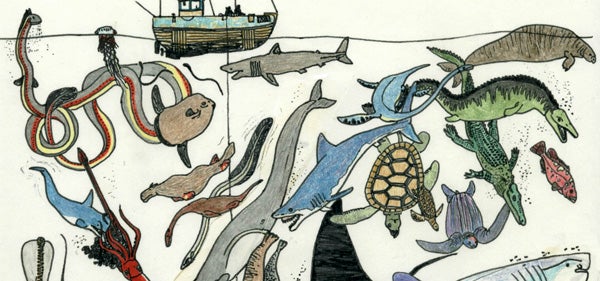
Sea monsters... look for the turtles. Credit: Darren Naish
For those of you who aren’t long-term readers here, sea monsters have been covered on Tet Zoo quite substantially over the years – see the links below. I’ve published several sea monster analyses too, a dated (but personally significant) article being Naish (2001); more recently I and colleagues had a go at using both mathematical extrapolation and quantitative analysis to identify given sea monsters (Woodley et al. 2008, 2011). Most recently I provided an overview of the state of our knowledge in my book Hunting Monsters (Naish 2016).
On supporting science journalism
If you're enjoying this article, consider supporting our award-winning journalism by subscribing. By purchasing a subscription you are helping to ensure the future of impactful stories about the discoveries and ideas shaping our world today.
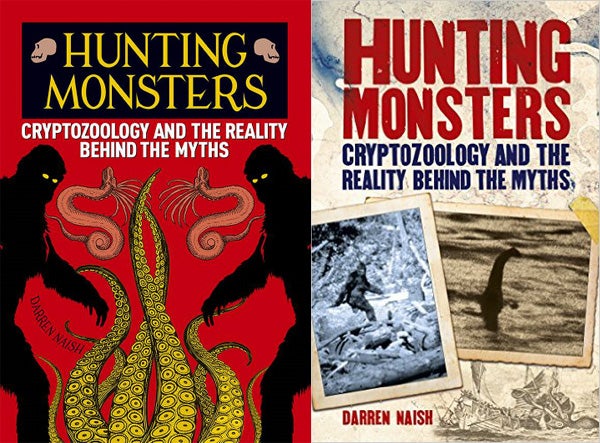
I might have mentioned this book before. Ebook cover at left, paper cover (yet to be released) at right. Credit: Arcturus Publishing
Today I want to talk about a really famous sea monster account from the September of 1959. The case occurred off the coast of Soay, an island – famous for sheep! – just south of Skye off the west coast of Scotland, and concerns basking shark fisherman Tex Geddes and engineer James Gavin. A point of interest is that Geddes purchased the shark-hunting business from Gavin Maxwell, generally associated with otters and his 1960 book Ring of Bright Water. Maxwell was never much able to turn a profit from the business, despite the various innovative techniques he devised to spear, kill and dismember one of the world’s largest fish. James Gavin and Gavin Maxwell have sometimes been confused and even intimated at times to be the same person. They were not.

The Soay monster as sketched by (A) Tex Geddes and (B) James Gavin. These drawings originally appeared in the Illustrated London News but are here reproduced from Heuvelmans (1968). Credit: Heuvelmans 1968
On seeing a large, dark, approaching object from their boat, Geddes and Gavin first heard it breathing and then had a reasonably close-up view of a large, hump-backed, scaly creature with a rounded, tortoise-like head, a “large red gash of a mouth”, and a prominently serrated back. It was likened at one point to a “hellish monster of prehistoric times”, was described as opening and closing its large mouth, of breathing through said mouth, and of having hanging structures of some sort within the mouth. They described the exposed part of the body as between 6 to 8 feet (Gavin) or 8 to 10 feet (Geddes) long and likened the head to that of a donkey in size, so this was a sizeable creature.
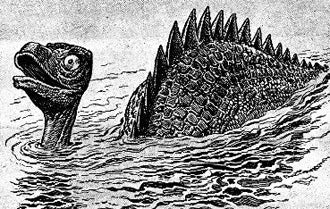
The Soay monster as depicted in the ILN. The artist is uncredited in the original caption. Credit: Illustrated London News
The sighting was interesting enough to make it into the national news media, most prominently The Illustrated London News (ILN from hereon). This was instigated by Geddes who wrote about the encounter to zoologist and author Maurice Burton (1898-1992), well known for his interest in weird animal stories and respected due in no small part to his position (vacated due to retirement in 1958) at the then British Museum in London. The fabulous thing about monster accounts published in the ILN is that they were invariably accompanied by highly sensationalised illustrations. The Soay creature thus morphed into a sea-going dragon of fabulous appearance, which for some reason I always imagined as green (the actually colour was never mentioned so far as I know). I’m reminded of historian Mike Dash’s talk ‘Our Artist Pictures What the Witness Saw’, which I saw Mike deliver at the Scholarly Research of the Anomalous conference in Edinburgh in 2015. Beyond talking to Burton, Geddes also discussed the event in his 1960 autobiography Hebridean Sharker. In fact, Geddes’ book even got a special mention in the caption to the ILN dragon illustration shown here… perhaps he was using the case to drum up interest in this work.

A childhood drawing of mine (from the mid-1980s) erroneously depicting the Soay monster as serpentine. I guess that this is the impression I received from the books I'd read. Credit: Darren Naish
So, what do we make of it? I think that this is one of those cases where we can make a fairly confident proposal as goes what Geddes and Gavin saw. A blunt, rounded head with a beak-like mouth, no indication of an especially long neck, and a body that is low in the water and possesses a serrated midline… it just has to be a sea turtle. A few modern sea turtles sometimes have tall, triangular dorsal scutes that create a serrated midline, namely the Loggerhead Caretta caretta and Kemp’s ridley Lepidochelys kempii. On the basis of that information, I concluded back in 2001 that either one of these was the species most likely behind the sighting (Naish 2001), even though neither can reach the size Geddes and Gavin reported. I redrew both Geddes’ and Gavin’s sketches next to my own drawing of a ridley to help emphasise the possibility that this best explained what they saw. And I thought that I might have been the first person to do such a thing…

(A) Another Soay monster drawing - a re-drawing of a re-drawing of a re-drawing (!) - together with re-drawings of (B) Geddes' and Gavin's drawings and (C) a Kemp's ridley, from Naish (2001). Credit: Naish 2001
I was aware that other writers had already suggested a turtle identity. Burton concluded in the ILN that it was a turtle but then flip-flopped a little. He initially suggested that the creature might have been a Leatherback or Leathery turtle Dermochelys coriacea. It has size on its side (it can exceed 2 m in total length) and is a confirmed visitor to Scottish waters. It can also look terrifying, on which read on. However, its smooth, rubbery, longitudinally ridged carapace doesn’t sound much like the macro-serrated midline of the Soay creature, so Burton then rejected this idea and suggested something more radical. Noting the presence of a few other, supposedly similar accounts from elsewhere in the world, he proposed that the sighting might have been of “some large turtle-like animal so far unidentified” (Burton, in Heuvelmans 1968).
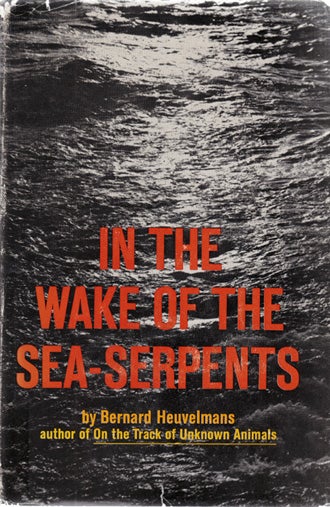
Cover of Heuvelmans (1968), still the most important work on sea monsters, despite its flaws. This is the cover of the second English edition, published in 1969. It's actually a scan of my own copy, a gift from a former secretary of the International Society of Cryptozoology. Credit: Heuvelmans 1968
Yes, an unknown species of big marine reptile. The proposed existence of one or more giant, unknown sea turtle (or sea-turtle-like) species is a familiar component of the sea monster literature. In his weighty 1968 tome In the Wake of the Sea-Serpents (and its 1965 French predecessor Le Grand Serpent de Mer: Le Problème Zoologique et Sa Solution), Bernard Heuvelmans endorsed the existence of a large, as yet unconfirmed sea turtle, said to have prominent eyes, a big, gash-like mouth, and serrated dorsal scutes (Heuvelmans 1968). This characterisation is clearly based on the Soay sighting, so it’s paradoxical that Heuvelmans also said that the sighting might actually pertain to another of his sea monsters: the Merhorse, a big-eyed, deep-diving pinniped (Heuvelmans 1968). This is actually a characteristic feature of Heuvelmans’ identification scheme – the more detailed an account, the less able he was to categorise it unambiguously (Magin 1996).
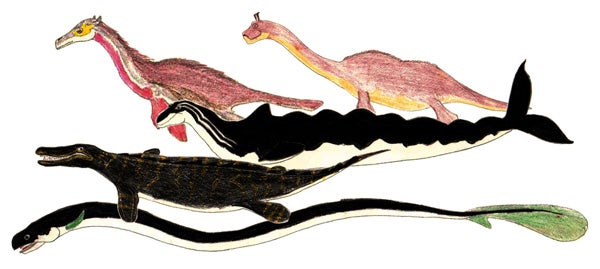
Old illustrations of some of the species endorsed in Heuvelmans' works on sea monsters (though the long-necked sea serpent at top right should not have a long tail). I need to produce updated versions of these drawings... they were created in the 1980s. The thing at top left is a Merhorse. Credit: Darren Naish
Incidentally, the hypothesis that there might be weird, giant, unknown turtle species – and that they are the true explanation behind various monster sightings – is present in the lake monster research community too. Some of the ideas are really interesting… by which I mean crazily speculative and non-credible (Naish 2016).
Anyway, post-Heuvelmans authors of a cryptozoological bent have also implied or preferred the idea that the Soay creature was, again, representative of an unknown species (Bright 1989, Harrison 2001). I said earlier that Burton flip-flopped on the creature. I recently rediscovered a book I recall from childhood: the 1974 The Life of Reptiles and Amphibians, co-authored by Burton and his son Robert Burton. Therein, we find another illustration that compares the Soay creature with a turtle – and here we find that Burton converted back to the Leatherback hypothesis he originally seemed to favour (Burton & Burton 1974).
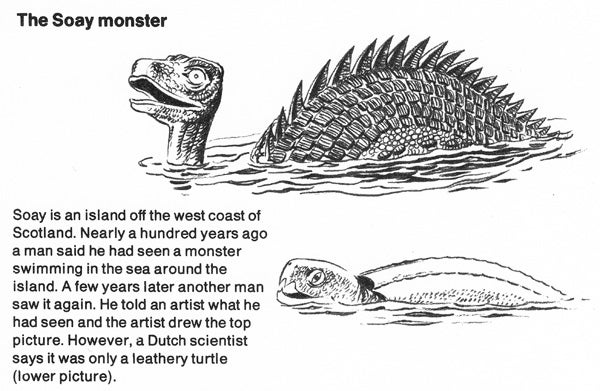
Burton redacted. An illustration and the accompanying caption from Burton & Burton (1974), a very nicely illustrated children's book on reptiles and amphibians. Credit: Burton & Burton 1974
And, on balance, I now think that this is the best explanation. The size of the Soay creature can’t be ignored. Even allowing for a bit of exaggeration, Gedes and Gavin clearly saw something that was quite large, and too large to be a ridley or loggerhead. A leatherback identity also matches the reference to structures within the mouth, since leatherbacks have unique spiny papillae inside the oral cavity. Think sarlacc pit (pre-special edition, sigh) but spinier. The other general features match up too, but what about that serrated back? Looking at Geddes’ original drawing, I think that those serrations have become exaggerated, especially in the ILN dragon illustration. Note that they were actually originally illustrated as low and numerous. I said earlier that Leatherbacks have smooth longitudinal ridges. In fact, those ridges can have a sort of nodular or serrated look, and I think that this is what Geddes was trying to depict.
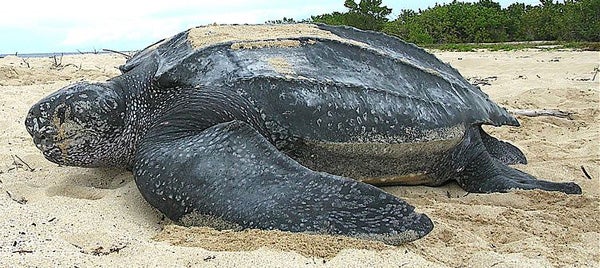
Those longitudinal ridges on the leatherback carapace can indeed have a serrated appearance. Credit: U.S. Fish and Wildlife Service Southeast Region Flickr (CC BY 2.0)
Incidentally, as much as I love turtles, I’ve often considered how terrifying it might be to have a really large one surface nearby when you’re in the water. The sheer overall size, hooked beak, large eyes, pinkish or whitish mouth interior and huffing and puffing noises made by a leatherback in particular might be really scary, especially to a naïve party who doesn’t appreciate how big a big turtle can be. And on that note, watch this video. It’s less than five minutes long and describes an event that happened off the coast of Rhode Island (aka Aquidneck Island... located within the state of Rhode Island) in 2007 or thereabouts. It’s incredible.
For previous Tet Zoo articles on sea monsters, see...
Statistics, seals and sea monsters in the technical literature
A Russian sea monster carcass is claimed to be that of an ancient 'archaeocete' whale
Phylogenetic roulette and the identification of sea monsters
Won't someone please think of the coelacanths, and other lamentations
A sea monster poster for the 9th European Symposium of Cryptozoology
A baby sea-serpent no more: reinterpreting Hagelund's juvenile Cadborosaurus
My New Book Hunting Monsters: Cryptozoology and the Reality Behind the Myths
Refs - -
Bright, M. 1989. There are Giants in the Sea. Robson Books Ltd, London.
Burton, M. & Burton, R. 1974. The Life of Reptiles and Amphibians. Macdonald and Co, London.
Harrison, P. 2001. Sea Serpents and Lake Monsters of the British Isles. Robert Hale, London.
Heuvelmans, B. 1969. In the Wake of the Sea-Serpents. Hill and Wang, New York.
Magin, U. 1996. St George without a dragon: Bernard Heuvelmans and the sea serpent. In Moore, S. (ed) Fortean Studies Volume 3. John Brown Publishing (London), pp. 223-234.
Naish, D. 2016. Hunting Monsters: Cryptozoology and the Reality Behind the Myths. Arcturus, London.